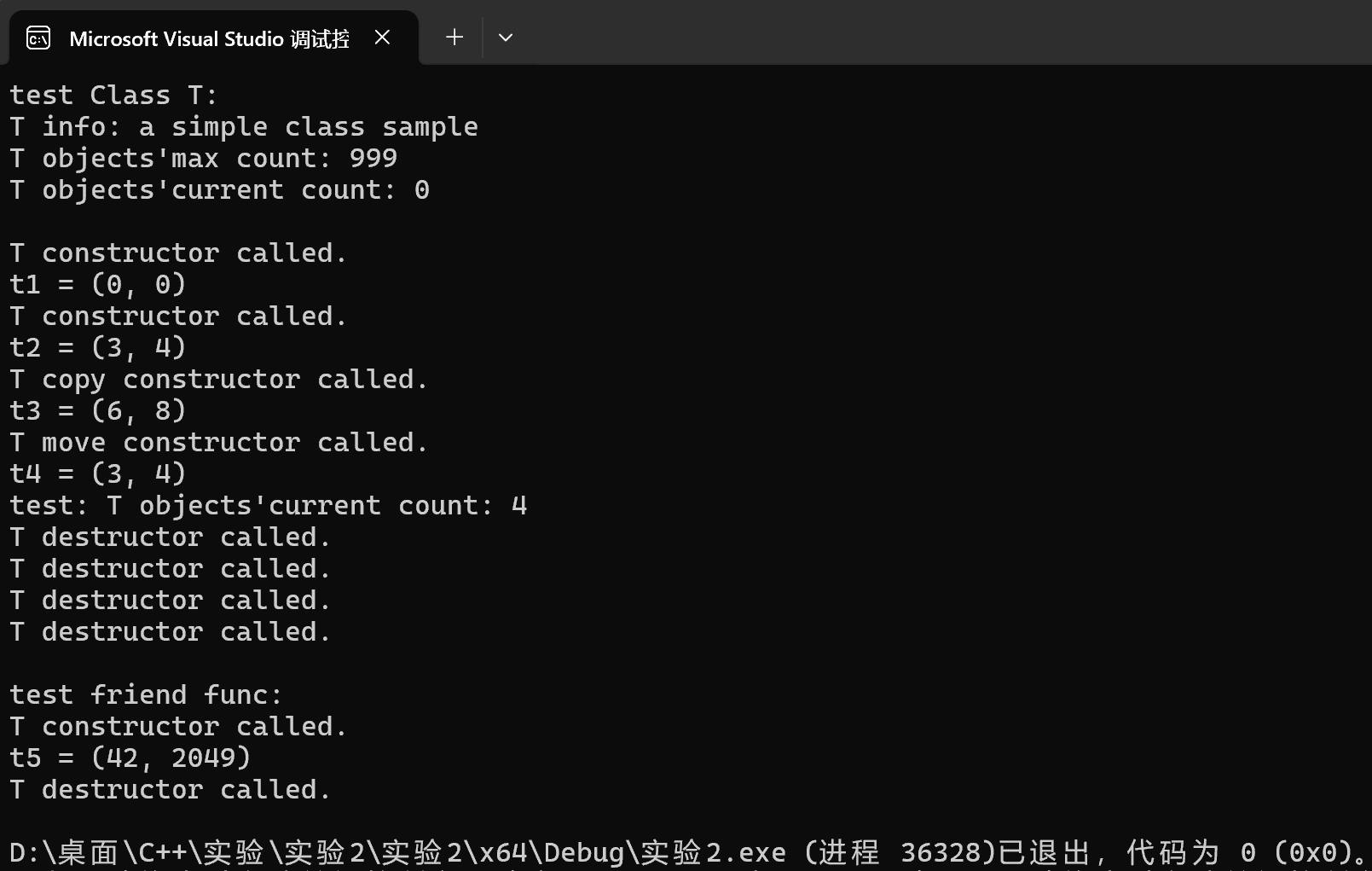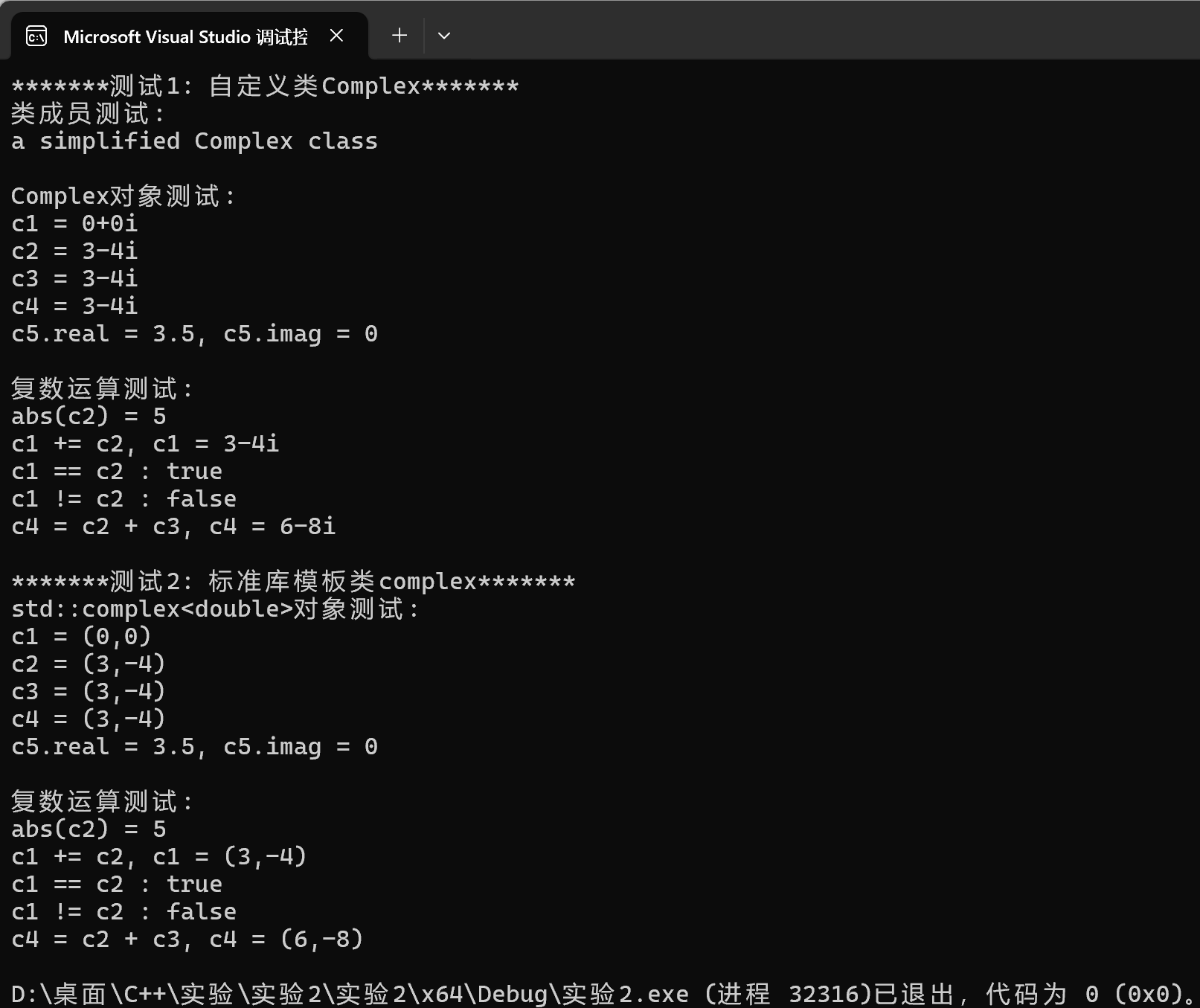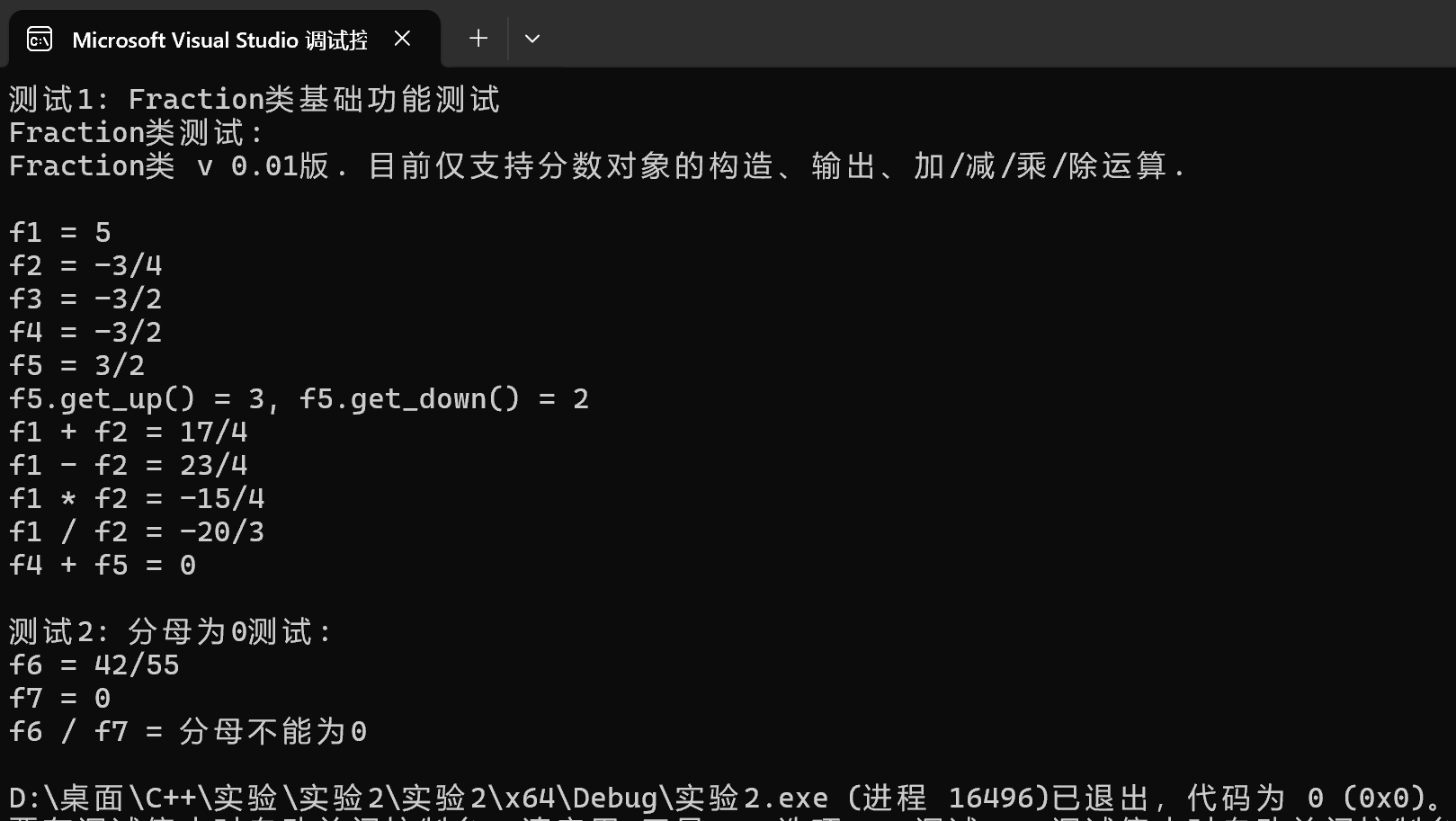实验2
实验任务1
源代码T.h
1 #pragma once 2 3 #include <string> 4 5 // 类T: 声明 6 class T { 7 // 对象属性、方法 8 public: 9 T(int x = 0, int y = 0); // 普通构造函数 10 T(const T &t); // 复制构造函数 11 T(T &&t); // 移动构造函数 12 ~T(); // 析构函数 13 14 void adjust(int ratio); // 按系数成倍调整数据 15 void display() const; // 以(m1, m2)形式显示T类对象信息 16 17 private: 18 int m1, m2; 19 20 // 类属性、方法 21 public: 22 static int get_cnt(); // 显示当前T类对象总数 23 24 public: 25 static const std::string doc; // 类T的描述信息 26 static const int max_cnt; // 类T对象上限 27 28 private: 29 static int cnt; // 当前T类对象数目 30 31 // 类T友元函数声明 32 friend void func(); 33 }; 34 35 // 普通函数声明 36 void func();
源代码T.cpp
1 #include "T.h" 2 #include <iostream> 3 #include <string> 4 5 // 类T实现 6 7 // static成员数据类外初始化 8 const std::string T::doc{"a simple class sample"}; 9 const int T::max_cnt = 999; 10 int T::cnt = 0; 11 12 // 类方法 13 int T::get_cnt() { 14 return cnt; 15 } 16 17 // 对象方法 18 T::T(int x, int y): m1{x}, m2{y} { 19 ++cnt; 20 std::cout << "T constructor called.\n"; 21 } 22 23 T::T(const T &t): m1{t.m1}, m2{t.m2} { 24 ++cnt; 25 std::cout << "T copy constructor called.\n"; 26 } 27 28 T::T(T &&t): m1{t.m1}, m2{t.m2} { 29 ++cnt; 30 std::cout << "T move constructor called.\n"; 31 } 32 33 T::~T() { 34 --cnt; 35 std::cout << "T destructor called.\n"; 36 } 37 38 void T::adjust(int ratio) { 39 m1 *= ratio; 40 m2 *= ratio; 41 } 42 43 void T::display() const { 44 std::cout << "(" << m1 << ", " << m2 << ")" ; 45 } 46 47 // 普通函数实现 48 void func() { 49 T t5(42); 50 t5.m2 = 2049; 51 std::cout << "t5 = "; t5.display(); std::cout << '\n'; 52 }
源代码task1.cpp
1 #include "T.h" 2 #include <iostream> 3 4 void test_T(); 5 6 int main() { 7 std::cout << "test Class T: \n"; 8 test_T(); 9 10 std::cout << "\ntest friend func: \n"; 11 func(); 12 } 13 14 void test_T() { 15 using std::cout; 16 using std::endl; 17 18 cout << "T info: " << T::doc << endl; 19 cout << "T objects'max count: " << T::max_cnt << endl; 20 cout << "T objects'current count: " << T::get_cnt() << endl << endl; 21 22 T t1; 23 cout << "t1 = "; t1.display(); cout << endl; 24 25 T t2(3, 4); 26 cout << "t2 = "; t2.display(); cout << endl; 27 28 T t3(t2); 29 t3.adjust(2); 30 cout << "t3 = "; t3.display(); cout << endl; 31 32 T t4(std::move(t2)); 33 cout << "t4 = "; t4.display(); cout << endl; 34 35 cout << "test: T objects'current count: " << T::get_cnt() << endl; 36 }
运行测试结果截图


原因:友元函数声明只是授予函数访问类私有成员的权限,而不会将函数引入全局作用域,因此main函数无法找到func的声明。

原因:静态成员变量在类外定义(初始化)时,如果放在头文件中,当多个 .cpp 文件包含该头文件时,会导致重复定义,违反了C++的单一定义规则。
实验任务2
源代码Complex.h
1 #pragma once 2 #include<string> 3 4 class Complex { 5 // 类属性 6 public: 7 static const std::string doc; 8 //对象属性 9 private: 10 double real; 11 double imag; 12 //对象方法 13 public: 14 //构造函数 15 Complex(double r = 0.0, double i = 0.0); //普通构造函数 16 Complex(const Complex& c1); //复制构造函数 17 //接口 18 double get_real() const; 19 double get_imag() const; 20 void add(const Complex& c1); 21 //友元函数 22 friend void output(const Complex& c); 23 friend double abs(const Complex& c); 24 friend Complex add(const Complex& c1, const Complex& c2); 25 friend bool is_equal(const Complex& c1, const Complex& c2); 26 friend bool is_not_equal(const Complex& c1, const Complex& c2); 27 28 }; 29 30 //友元函数声明 31 void output(const Complex& c); 32 double abs(const Complex& c); 33 Complex add(const Complex& c1, const Complex& c2); 34 bool is_equal(const Complex& c1, const Complex& c2); 35 bool is_not_equal(const Complex& c1, const Complex& c2);
源代码Complex.cpp
1 #include"Complex.h" 2 #include<iostream> 3 #include<cmath> 4 const std::string Complex::doc = "a simplified Complex class"; 5 6 //构造函数 7 Complex::Complex(double r, double i) :real(r), imag(i) {} 8 Complex::Complex(const Complex& c1) :real(c1.real), imag(c1.imag) {} 9 10 //成员接口 11 double Complex::get_real() const { 12 return real; 13 } 14 double Complex::get_imag() const { 15 return imag; 16 } 17 void Complex::add(const Complex& c1) { 18 real += c1.real; 19 imag += c1.imag; 20 } 21 22 //友元函数 23 void output(const Complex& c) { 24 std::cout << c.real; 25 if (c.imag >= 0) { 26 std::cout << '+' << c.imag << 'i'; 27 } 28 else { 29 std::cout << '-' << -c.imag << 'i'; 30 } 31 } 32 double abs(const Complex& c) { 33 return std::sqrt(c.real * c.real + c.imag * c.imag); 34 } 35 Complex add(const Complex& c1, const Complex& c2) { 36 return Complex(c1.real + c2.real, c1.imag + c2.imag); 37 } 38 bool is_equal(const Complex& c1, const Complex& c2) { 39 return c1.real == c2.real && c1.imag == c2.imag; 40 } 41 bool is_not_equal(const Complex& c1, const Complex& c2) { 42 return c1.real != c2.real || c1.imag != c2.imag; 43 }
源代码task2.cpp
1 #include "Complex.h" 2 #include <iostream> 3 #include <iomanip> 4 #include <complex> 5 6 void test_Complex(); 7 void test_std_complex(); 8 9 int main() { 10 std::cout << "*******测试1: 自定义类Complex*******\n"; 11 test_Complex(); 12 13 std::cout << "\n*******测试2: 标准库模板类complex*******\n"; 14 test_std_complex(); 15 } 16 17 void test_Complex() { 18 using std::cout; 19 using std::endl; 20 using std::boolalpha; 21 22 cout << "类成员测试: " << endl; 23 cout << Complex::doc << endl << endl; 24 25 cout << "Complex对象测试: " << endl; 26 Complex c1; 27 Complex c2(3, -4); 28 Complex c3(c2); 29 Complex c4 = c2; 30 const Complex c5(3.5); 31 32 cout << "c1 = "; output(c1); cout << endl; 33 cout << "c2 = "; output(c2); cout << endl; 34 cout << "c3 = "; output(c3); cout << endl; 35 cout << "c4 = "; output(c4); cout << endl; 36 cout << "c5.real = " << c5.get_real() 37 << ", c5.imag = " << c5.get_imag() << endl << endl; 38 39 cout << "复数运算测试: " << endl; 40 cout << "abs(c2) = " << abs(c2) << endl; 41 c1.add(c2); 42 cout << "c1 += c2, c1 = "; output(c1); cout << endl; 43 cout << boolalpha; 44 cout << "c1 == c2 : " << is_equal(c1, c2) << endl; 45 cout << "c1 != c2 : " << is_not_equal(c1, c2) << endl; 46 c4 = add(c2, c3); 47 cout << "c4 = c2 + c3, c4 = "; output(c4); cout << endl; 48 } 49 50 void test_std_complex() { 51 using std::cout; 52 using std::endl; 53 using std::boolalpha; 54 55 cout << "std::complex<double>对象测试: " << endl; 56 std::complex<double> c1; 57 std::complex<double> c2(3, -4); 58 std::complex<double> c3(c2); 59 std::complex<double> c4 = c2; 60 const std::complex<double> c5(3.5); 61 62 cout << "c1 = " << c1 << endl; 63 cout << "c2 = " << c2 << endl; 64 cout << "c3 = " << c3 << endl; 65 cout << "c4 = " << c4 << endl; 66 67 cout << "c5.real = " << c5.real() 68 << ", c5.imag = " << c5.imag() << endl << endl; 69 70 cout << "复数运算测试: " << endl; 71 cout << "abs(c2) = " << abs(c2) << endl; 72 c1 += c2; 73 cout << "c1 += c2, c1 = " << c1 << endl; 74 cout << boolalpha; 75 cout << "c1 == c2 : " << (c1 == c2) << endl; 76 cout << "c1 != c2 : " << (c1 != c2) << endl; 77 c4 = c2 + c3; 78 cout << "c4 = c2 + c3, c4 = " << c4 << endl; 79 }
运行结果测试截图

答:是,output 函数直接使用了 c.real 和 c.imag 进行输出,abs 函数使用了 c.real 和 c.imag 计算模长。add 函数使用了 c1.real, c1.imag, c2.real, c2.imag 计算和,这些函数确实需要被声明为友元以便访问 Complex 类的私有数据。
答:否,标准库的 std::abs 函数不是 std::complex 类的友元函数。std::abs 是一个独立的函数模板,它可以接受 std::complex 类型的参数。它通常通过调用 std::complex 的公共成员函数 real() 和 imag() 来访问数据。
explicit Complex(const Complex& c1);
explicit 关键字阻止编译器在隐式转换和拷贝初始化中使用该构造函数
1 #pragma once 2 #include <string> 3 enum class ControlType { Play, Pause, Next, Prev, Stop, Unknown }; 4 class PlayerControl { 5 public: 6 PlayerControl(); 7 ControlType parse(const std::string& control_str); // 实现std::string -->ControlType转换 8 void execute(ControlType cmd) const; // 执行控制操作(以打印输出模拟) 9 static int get_cnt(); 10 private: 11 static int total_cnt; 12 };
源代码PlayerControl.cpp
1 #include "PlayerControl.h" 2 #include <iostream> 3 #include <algorithm> 4 int PlayerControl::total_cnt = 0; 5 PlayerControl::PlayerControl() {} 6 7 ControlType PlayerControl::parse(const std::string& control_str) { 8 // 1. 将输入字符串转为小写,实现大小写不敏感 9 std::string lower_str; 10 for (char c : control_str) 11 lower_str += std::tolower(c); 12 // 2. 匹配命令并返回对应枚举 13 ControlType result; 14 15 if (lower_str == "play") { 16 result = ControlType::Play; 17 } 18 else if (lower_str == "pause") { 19 result = ControlType::Pause; 20 } 21 else if (lower_str == "next") { 22 result = ControlType::Next; 23 } 24 else if (lower_str == "prev") { 25 result = ControlType::Prev; 26 } 27 else if (lower_str == "stop") { 28 result = ControlType::Stop; 29 } 30 else {// 3. 未匹配的字符串返回ControlType::Unknown 31 result = ControlType::Unknown; 32 } 33 // 4. 每次成功调用parse时递增total_cnt 34 if (result != ControlType::Unknown) { 35 total_cnt++; 36 } 37 return result; 38 } 39 void PlayerControl::execute(ControlType cmd) const { 40 switch (cmd) { 41 case ControlType::Play: std::cout << "[play] Playing music...\n"; break; 42 case ControlType::Pause: std::cout << "[Pause] Music paused\n"; break; 43 case ControlType::Next: std::cout << "[Next] Skipping to next track\n"; break; 44 case ControlType::Prev: std::cout << "[Prev] Back to previous track\n"; break; 45 case ControlType::Stop: std::cout << "[Stop] Music stopped\n"; break; 46 default: std::cout << "[Error] unknown control\n"; break; 47 } 48 } 49 int PlayerControl::get_cnt() { 50 return total_cnt; 51 }
源代码task3.cpp
1 #include "PlayerControl.h" 2 #include <iostream> 3 void test() { 4 PlayerControl controller; 5 std::string control_str; 6 std::cout << "Enter Control: (play/pause/next/prev/stop/quit):\n"; 7 while (std::cin >> control_str) { 8 if (control_str == "quit") 9 break; 10 ControlType cmd = controller.parse(control_str); 11 controller.execute(cmd); 12 std::cout << "Current Player control: " << PlayerControl::get_cnt() << "\n\n"; 13 } 14 } 15 int main() { 16 test(); 17 }
运行结果测试截图

实验任务4
源代码Fraction.h
1 #pragma once 2 #include <string> 3 #include <iostream> 4 5 class Fraction { 6 public: 7 // 类属性 8 static const std::string doc; 9 10 // 构造函数 11 Fraction(int u = 0, int d = 1); 12 Fraction(const Fraction& f); 13 14 // 接口 15 int get_up() const; 16 int get_down() const; 17 Fraction negative() const; 18 19 private: 20 // 对象属性 21 int up; 22 int down; 23 24 // 友元函数 25 friend void output(const Fraction& f); 26 friend Fraction add(const Fraction& f1, const Fraction& f2); 27 friend Fraction sub(const Fraction& f1, const Fraction& f2); 28 friend Fraction mul(const Fraction& f1, const Fraction& f2); 29 friend Fraction div(const Fraction& f1, const Fraction& f2); 30 }; 31 32 // 工具函数声明 (使用友元函数方案) 33 void output(const Fraction& f); // 34 Fraction add(const Fraction& f1, const Fraction& f2); // 35 Fraction sub(const Fraction& f1, const Fraction& f2); // 36 Fraction mul(const Fraction& f1, const Fraction& f2); // 37 Fraction div(const Fraction& f1, const Fraction& f2); //
源代码Fraction.cpp
1 #include "Fraction.h" 2 #include <iostream> 3 4 //辅助函数: 最大公约数 5 int gcd(int a, int b) { 6 while (b) { 7 a %= b; 8 std::swap(a, b); 9 } 10 return a; 11 } 12 13 // 类属性初始化 14 const std::string Fraction::doc = "Fraction类 v 0.01版. 目前仅支持分数对象的构造、输出、加/减/乘/除运算."; 15 16 // 构造函数实现 17 Fraction::Fraction(int u, int d) : up(u), down(d) { 18 if (down == 0) { 19 return; 20 } 21 if (down < 0) { 22 up = -up; 23 down = -down; 24 } 25 int common = gcd(std::abs(up), down); 26 up /= common; 27 down /= common; 28 } 29 30 Fraction::Fraction(const Fraction& f) : up(f.up), down(f.down) {} // 拷贝构造函数 31 32 // 接口实现 33 int Fraction::get_up() const { return up; } 34 int Fraction::get_down() const { return down; } 35 Fraction Fraction::negative() const { 36 return Fraction(-up, down); 37 } 38 39 // 友元工具函数实现 40 // 输出分数 41 void output(const Fraction& f) { 42 if (f.down == 0) { 43 std::cout << "分母不能为0"; 44 } 45 else if (f.down == 1) { 46 std::cout << f.up; 47 } 48 else { 49 std::cout << f.up << "/" << f.down; // 输出化简后的形式 50 } 51 } 52 53 Fraction add(const Fraction& f1, const Fraction& f2) { 54 int new_up = f1.up * f2.down + f2.up * f1.down; 55 int new_down = f1.down * f2.down; 56 return Fraction(new_up, new_down); 57 } 58 59 Fraction sub(const Fraction& f1, const Fraction& f2) { 60 int new_up = f1.up * f2.down - f2.up * f1.down; 61 int new_down = f1.down * f2.down; 62 return Fraction(new_up, new_down); 63 } 64 65 Fraction mul(const Fraction& f1, const Fraction& f2) { 66 int new_up = f1.up * f2.up; 67 int new_down = f1.down * f2.down; 68 return Fraction(new_up, new_down); 69 } 70 71 Fraction div(const Fraction& f1, const Fraction& f2) { 72 if (f2.up == 0) { 73 // 返回一个分母为 0 的特殊 Fraction 对象 74 return Fraction(0, 0); 75 } 76 int new_up = f1.up * f2.down; 77 int new_down = f1.down * f2.up; 78 return Fraction(new_up, new_down); // 返回化简后的分数 79 }
源代码task4.cpp
1 #include "Fraction.h" 2 #include <iostream> 3 void test1(); 4 void test2(); 5 int main() { 6 std::cout << "测试1: Fraction类基础功能测试\n"; 7 test1(); 8 std::cout << "\n测试2: 分母为0测试: \n"; 9 test2(); 10 } 11 void test1() { 12 using std::cout; 13 using std::endl; 14 cout << "Fraction类测试: " << endl; 15 cout << Fraction::doc << endl << endl; 16 Fraction f1(5); 17 Fraction f2(3, -4), f3(-18, 12); 18 Fraction f4(f3); 19 cout << "f1 = "; output(f1); cout << endl; 20 cout << "f2 = "; output(f2); cout << endl; 21 cout << "f3 = "; output(f3); cout << endl; 22 cout << "f4 = "; output(f4); cout << endl; 23 const Fraction f5(f4.negative()); 24 cout << "f5 = "; output(f5); cout << endl; 25 cout << "f5.get_up() = " << f5.get_up() 26 << ", f5.get_down() = " << f5.get_down() << endl; 27 cout << "f1 + f2 = "; output(add(f1, f2)); cout << endl; 28 cout << "f1 - f2 = "; output(sub(f1, f2)); cout << endl; 29 cout << "f1 * f2 = "; output(mul(f1, f2)); cout << endl; 30 cout << "f1 / f2 = "; output(div(f1, f2)); cout << endl; 31 cout << "f4 + f5 = "; output(add(f4, f5)); cout << endl; 32 } 33 void test2() { 34 using std::cout; 35 using std::endl; 36 Fraction f6(42, 55), f7(0, 3); 37 cout << "f6 = "; output(f6); cout << endl; 38 cout << "f7 = "; output(f7); cout << endl; 39 cout << "f6 / f7 = "; output(div(f6, f7)); cout << endl; 40 }
运行结果测试截图

答:我选择使用友元函数因为:1. 直接访问私有成员 (up, down),实现分数运算高效简洁。 2. 保持函数调用形式 (如add(f1, f2)) 的数学对称性和自然性。 3.二元操作天然是对称的,自友元函数可以更好地体现这种对称性,使两个操作数处于平等的地位。




 浙公网安备 33010602011771号
浙公网安备 33010602011771号